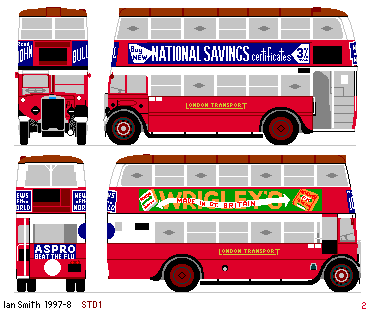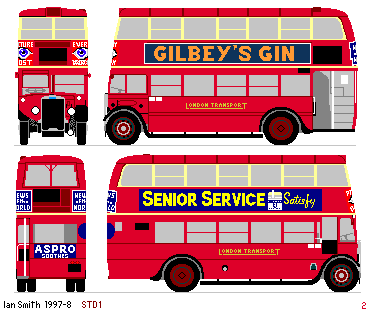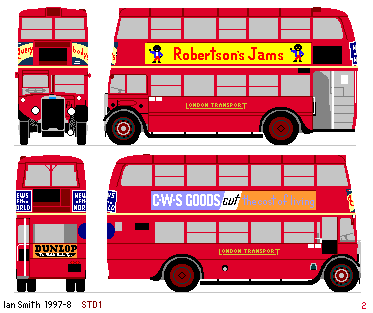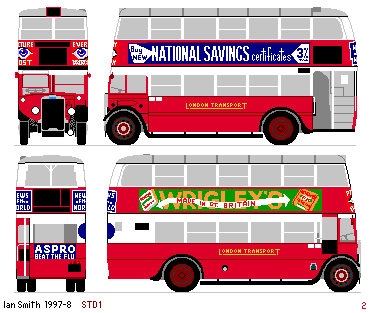
The LONDON TRANSPORT STDsThis page created December 1997 by Ian Smith, updated 14th October 1999ContentsThere were three distinct groups of STDs:
The Pre-war STDs
Introduced: April 1937. |
| Dates | Routes | Buses displaced |
|---|---|---|
| 4/37- | 13: Hendon - London Bridge Station | NS |
| 4/37-10/38 | 16 (Su): West Hendon - Victoria Station | NS |
| 4/37- | 28: Hendon/Golders Green - Wandsworth Bridge | NS |
| 4/37- | 52: Mill Hill - Victoria Stn | STL |
| 4/37-6/39 | 83: (NSu) Golders Green Stn - Southall | ST |
| 4/37-6/39 | 83A: (Su)Golders Green Stn - Kew | ST |
| 4/37- | 113: (NSu) Hendon Central Stn - Edgware Stn | STL |
| 4/37-10/38 (5/39 Sun) | 121: Hendon Garage - Nunhead Garage | ST |
| 4/37- | 183: Golders Green Stn - Northwood Stn | ST |
| 5/39-10/39 | 3A: Edgware Stn - Crystal Palace | new |
| 5/39-11/39 | 112: (SumSu) Edmonton - Hampton Court | new |
| 6/39-12/39 | 240: Golders Green Stn - Mill Hill | extra |
The handsome new STDs were well received. They looked good. They went well. They were economical on fuel - and engines. They had fewer call-outs than the STLs. They were so successful that AEC were instructed to improve their engines, from which the new Regals benefitted. The torque-converter STDs were less successful, proving thirsty and unreliable. After two years they were converted to standard crash gearboxes.
War-time changes
 As war approached the buses were readied for the impending blackout,
with reduced headlights,
white roundels on the rear (to distinguish them from trolleybuses),
and white trim on mudguards and the platform.
The bright aluminium coloured roofs were darkened by a coat of red-oxide or brown paint.
Blinds were reduced to save linen.
As the air-raids finally started the buses were also fitted with anti-splinter netting,
with cut-outs to allow passengers to see where they were. (Unlike some modern paint schemes!)
As war approached the buses were readied for the impending blackout,
with reduced headlights,
white roundels on the rear (to distinguish them from trolleybuses),
and white trim on mudguards and the platform.
The bright aluminium coloured roofs were darkened by a coat of red-oxide or brown paint.
Blinds were reduced to save linen.
As the air-raids finally started the buses were also fitted with anti-splinter netting,
with cut-outs to allow passengers to see where they were. (Unlike some modern paint schemes!)
The war also brought revisions of routes and allocations: from 1st September STDs 1-17 (plus five others) were delicensed as surplus following service reductions and revised working to cut down on garage runs. But they were too good to keep in store, and were promptly relicensed. They, or others, were sent out to the Country Area to replace duties of GreenLine coaches that had been converted to Ambulances. They went to :
Hatfield (HF): STD 15, 22, 56, 58, 74;
Staines (ST): STD 42, 81, 95;
Luton (LS), then St Albans (SA): STD 29, 39, 47, 68, 76.
The receiving garages did not appreciate them, and they were soon stored at Tring (TG), before coming back to the Central Area at Cricklewood (W) in mid-October. There they worked alongside STLs on route 16 for three years.
From October 1939 Hendon's 112 was dropped, replaced by running the 113 on Sundays. The 113 was also extended daily to Oxford Circus. The 13 was shortened in the off peaks, to Golders Green Stn - London Bridge Stn.
When the 112 finished its summer season, in November, Hendon was given work for STDs on route 142, followed by Sunday work on a revised route 83.
| Dates | Routes |
|---|---|
| 11/39- | 142: Kilburn Park Stn - Watford Junction Stn |
| 12/39-3/40 | 83: Golders Green Stn - Ealing Broadway |
In October 1942 the Cricklewood STDs were mostly returned to Hendon, but five (STD 22, 47, 49, 56 and 58) went instead to Victoria garage (GM), where they continued to work on the 16 for another two years. Victoria reallocated them to route 22 in October 1944, and received five more from Hendon to join them (STD 5, 7, 13, 16, 37). All ten returned to Hendon in August 1945.
| Dates | Routes |
|---|---|
| 10/42-10/44/ | 16: West Hendon - Victoria Station |
| 10/44-8/45 | 22: Putney Common - Homerton |
Edgware (EW) borrowed some from AE and W at times too.

Peace returns
With the STDs all back at Hendon, they resumed work on the routes familiar to them: the 13, 113, and 183 during the week, and the 140, 142, 240 and 260 at weekends.
Post-war repaints saw the buses go into a red livery
with a cream cant-rail and cream upper window surrounds.
But this was short-lived, the window surrounds soon succumbing to the tide of red paint.
The restricted blinds stayed restricted: the STDs were seen as having a limited life as the RTs took over.
Exit Hendon, enter Enfield
The 1950s brought new buses: thirty-four RTLs appeared at Hendon in December 1951 for route 13 (a route shared with Cricklewood, which had had RTs from March 1948) So in January 1952 some STDs started to appear as trainers at Ponders End garage, Enfield (E), whilst others were stored at Edgware (EW). In February they replaced austerity G's on the 107/A routes. 37 of the STDs were engaged at Enfield.| Dates | Routes |
|---|---|
| 2/52 - | 107/A: Borehamwood - Ponders End/Enfield Lock |
| 2/52 - | 135: Forty Hill - Enfield Town /Brimsdown Power Stn |
 More RTs arrived at Hendon in October 1952, and during 1953,
gradually ousting the remaining STDs.
But 64 lasted in LT passenger service into 1954, at Hendon and Enfield,
and some lasted into '55 as trainers.
They were all sold between December 1953 and September 1955.
Some went for further bus service, others became contractors' staff vehicles.
Others had the bodies scrapped and new lorry bodies fitted.
More RTs arrived at Hendon in October 1952, and during 1953,
gradually ousting the remaining STDs.
But 64 lasted in LT passenger service into 1954, at Hendon and Enfield,
and some lasted into '55 as trainers.
They were all sold between December 1953 and September 1955.
Some went for further bus service, others became contractors' staff vehicles.
Others had the bodies scrapped and new lorry bodies fitted.
Beyond the tender loving care of LT the survivors gradually faded away.
One, STD90, after further service in the Midlands, was headed for preservation,
but had to be scrapped after being badly vandalised in the early sixties.
![]()
 Ian's Bus Stop
Ian's Bus Stop
 bus histories
bus histories
 photo refs
photo refs
![]()
 STLs
STLs
 prewar STDs
prewar STDs
 war-time STDs
war-time STDs
 postwar STDs
postwar STDs
 SRTs
SRTs
![]()
 Chassis: Leyland Titan TD4 , 16ft 3in wheel-base, 6 cylinder 8.6 litre diesel,
crash gearboxes (1STD) or torque converters (2STD)
Chassis: Leyland Titan TD4 , 16ft 3in wheel-base, 6 cylinder 8.6 litre diesel,
crash gearboxes (1STD) or torque converters (2STD)